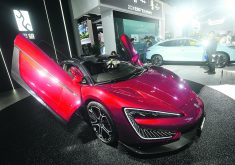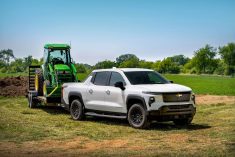When it was time to buy a new vehicle for family use, the Somervilles went electric.
Rob Somerville, who farms cattle and grain with his wife, son and daughter-in-law near Endiang, Alta., cited costs as the main reason for the decision.
Somerville knew the costs of his previous vehicle. Fuel and repairs had reached the point where the old standby was no longer worth it. He needed something cheaper. Although many farming peers might question his choice, he decided an electric truck was the best option.
Read Also

Pakistan reopens its doors to Canadian canola
Pakistan reopens its doors to Canadian canola after a three-year hiatus.
“If you set aside the purchase price, that’s the cheapest driving that you can get,” he said, adding that his vehicle “runs for about 25 per cent of the cost at today’s prices and we expect the price of gas and diesel to go up.”
The family’s previous “going to town” vehicle used 10 litres per 100 kilometres.
“We put on a lot of kilometres in a year because of our distance. We averaged 93,000 kilometres per year on that car.”
The farm’s diesel SUV cost an estimated $10,000 to $11,000 last year. Somerville said electrical costs for the new truck will be $4,000 annually for the same number of kilometres.
“Over the lifetime that we intend to own this vehicle, the savings in fuel will be $70,000,” he said, noting his family tends to extend the lifespan of vehicles.
Somerville bought his Ford F-150 Lightning on April 2.
“Its payload is about 2,000 pounds, so it’s not a toy truck. This is a Ford half-ton truck.”
The price range for electric trucks can vary. Somerville saw some on the dealership’s lot with $60,000 pricetags. Others were listed up to $100,000.
Part of that involves range. Extended range vehicles feature a double battery to give the driver more wiggle room between charging stations, but prices are high for that feature.
Somerville said his new truck has a range of about 400 km on a cool spring day. In the cold, that range shrinks, which was one of the criticisms of electric vehicles (EVs) this winter after a polar vortex swept through the Prairies, dropping the whole region into frigid temperatures for days.
“We don’t know how much range we’re going to lose if it gets cold because there’s different reports,” Somerville said. “There’s a lot of misinformation about electric trucks, but we do know that the range is going to go down as it gets cold.”
Once a person buys the truck, there are apps to identify charging station locations.
“We do have range anxiety. That’s the uncertainty. Will this truck get us to where we want to go?”
There are not a lot of charging stations in the eastern part of Alberta and some are only level two stations that provide less power and take longer for a charge. Major cities have faster level three charging stations.
Charge times and their consequent extension of travel times on long trips are another target for EV critics. It can take 30 to 45 minutes to charge Somerville’s vehicle using the level two charging station in the nearby community of Stettler.
“So typically, if we went to Stettler, and we needed to charge, you would just put in enough charge to get home. You wouldn’t fill it up because it would take too long.”
The electric truck can also be charged at home. It comes with two chargers. When the Somervilles bought, they were sent home with one charger that can charge the battery in 12 hours. In a few weeks, they expect to get a faster charger that will require three to four hours.
The truck may look like any Ford F-150, but it has several distinct differences.
“You open the hood to the truck and there’s no engine there. It’ s kind of strange, actually. They use it for storage, just like those old Volkswagen beetles,” said Somerville.
There’s no sound in the cab either. When driving, he can hear a little wind and a bit of tire noise. The truck itself is silent.
Somerville said he and his family never investigated the environmental impacts of owning an electric vehicle.
“We were very focused just overall on the farm, of finding ways to reduce our fixed costs. We regarded our ‘going to town’ vehicle as a fixed cost.”
His truck is a 2023 model. Newer models heat the cab with a heat pump rather than an electric heating element. Heat pumps are designed to be more efficient on electricity.
“In the wintertime, my range would be better if we had a 2024 truck versus a 2023. But they aren’t available (yet),” he said.
















